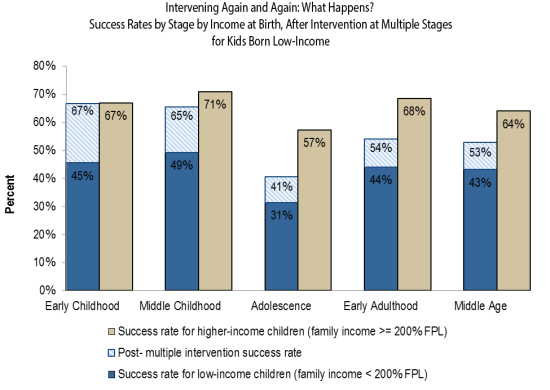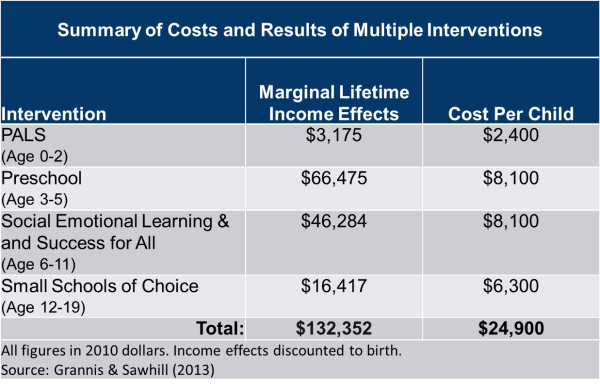Teens vs. Toddlers: When to Intervene?: Last of a four-part series examining the debate over when to intervene to improve social mobility.
Which life stage is most important in terms of promoting greater social mobility? Early childhood or adolescence – toddlers or teens? That is the question we’ve been wrestling with in this series. Our conclusion so far is that multiple interventions are required. Today, we’ll put that idea to the test.
Multiple Interventions: a Benchtest
We know that a single early childhood intervention, such as high-quality preschool, might greatly improve kids’ school readiness at age 5, but that often the impact fades: performance gaps re-open and grow in elementary school and beyond. But what would happen if the gains from an intervention in one life stage were reinforced by intervening again in each subsequent stage, until adulthood?
Using the Brookings Social Genome Model we have tested the impact of this “kitchen sink” strategy, published as “Improving Children’s Life Chances: Estimates from the Social Genome Model.” We simulated the combined effect of the following interventions:
- Birth: a program to improve parenting skills (such as PALS)
- Early Childhood: high quality preschool
- Elementary School: a strong social-emotional learning program and an effective reading curriculum (Success for All).
- Adolescence: a high school such as New York City’s small schools of choice, which have been shown to significantly improve graduation rates, among other outcomes.
Our simulation estimates how a sustained approach to intervention might impact the gap between lower- and higher-income individuals at each life stage:

High Return on Investment
These multiple interventions seem to pass a simple cost-benefit test: the total cost per child for these programs combined is just under $25,000. Our estimates suggest the lifetime income of the average individual receiving these programs would increase by more than $132,000. It’s likely that there would also be additional positive benefits, including the additional taxes raised from the additional income, savings on social safety net benefits, and from lower costs for crime, poor health, and related social problems.

When to Intervene?
So, should we intervene in early childhood or adolescence? With toddlers or teens? The answer, it seems, is yes. We need to intervene early childhood, and then again, and then again. Just as there is no “magic bullet” for policy, there is no “magic life-stage” for interventions.
Rather than waiting for some heroic program, whose implementation at a single life stage will provide massive, permanent results, we should pursue a sustained, evidence-based multi-stage approach. Moving the needle on social mobility requires patience, investment, and constancy from our policy-makers. But few challenges are more pressing.


Commentary
Multiple Interventions for Social Mobility
November 7, 2013